

Destination A* Analyzing Primary Sources. Three Questioning Strategies for Any Lesson. Teachers know—questions play a different role, depending on when they're used. Questions are a way to motivate, set goals, stimulate thinking, convey purpose, and create a positive learning environment. Questions inspire thinking and reflection, allow students to review what they're learning, involve students in evaluating their understanding of implicit and explicit learning, and encourage students to think ahead – to predict, anticipate, problem solve, and identify trends and patterns.
Questions prompt students to summarize what they learned, make analogies, reflect, draw conclusions, incorporate new learning with prior learning, and extend learning. In her ASCD Annual Conference session, Sandra Page presented several questioning strategies that can be used at all stages of a lesson: On one side of an index card, students write their name large enough to be seen across the room. Student sort cards are also useful for getting students to discuss a topic with one another. Five close reading strategies to support the Common Core. I walked in to my first college class, Political Science 101, eager to learn.

For my inaugural college assignment, my professor asked the class to read the first three chapters of the textbook for the next class period. That night, I returned to my dorm room, determined to learn everything I could in those three chapters. Word Clouds Cyberman. Ten Takeaway Tips for Teaching Critical Thinking.
Suggestions from educators at KIPP King Collegiate High School on how to help develop and assess critical-thinking skills in your students.
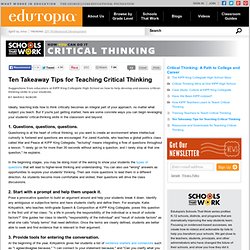
Ideally, teaching kids how to think critically becomes an integral part of your approach, no matter what subject you teach. But if you're just getting started, here are some concrete ways you can begin leveraging your students' critical-thinking skills in the classroom and beyond. 1. Questions, questions, questions. Scaffolding Complex Texts Strategies. The explicit teaching of reading strategies helps students to become increasingly skillful at interpreting, understanding, and analyzing text.

As with any new skill, these reading strategies should be taught through a scaffolding method, which includes modeling the strategy, providing students with opportunities for guided practice with the strategy, and then having students independently apply the strategy. Because students have different reading styles, they are not likely to find all reading strategies equally useful.
While a particular strategy may reinforce a strength that one student has or may provide the key to overcoming a reading difficulty, the same strategy may prove to be cumbersome or tedious to another student. Flowcabulary- hip hop grammar vids. Teaching bias w/ the Simpsons. Teaching English. The Harlem Renaissance: a documentary drama. Harlem_handout1. 'Ain't Nothing Like the Real Thing' Exhibit Puts Apollo Theater in Spotlight. Built in 1914 and originally named Hurtig and Seamon’s New Burlesque Theatre, Harlem’s famous Apollo Theater first catered to whites only.

However, ownership changed hands in 1934 and a new era in black entertainment and American pop culture was launched. An installation chronicling the history of the landmark theater is on display at the Smithsonian Museum of African-American History and Culture in Washington, D.C. “Ain’t Nothing Like the Real Thing” takes visitors on a ride into the theater’s rich history with rarely displayed artifacts from Sammy Davis, Jr., Celia Cruz and Michael Jackson, who won Amateur Night in 1967 as a member of the Jackson 5. The exhibit leaves Washington at the end of August. 201 Ways to Arouse Your Creativity. Arouse your creativity Electric flesh-arrows … traversing the body.

A rainbow of color strikes the eyelids. A foam of music falls over the ears. Peace Education Resources. Chicago's Peace Warriors. By Kazu Haga Purchase a PDF of this article Winter 2011-2012.
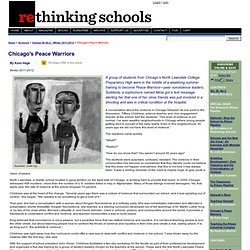
Reading Fiction Whole. Published Online: February 29, 2012 Published in Print: February 29, 2012, as Reading Fiction Whole.
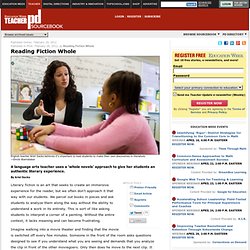
Literary Terms. Web English Teacher. The Power of Oratory in the United States. The N-Word Transcript. BOB GARFIELD: This is On the Media.
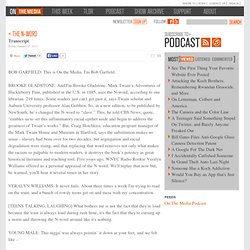
I'm Bob Garfield. BROOKE GLADSTONE: And I'm Brooke Gladstone. Mark Twain’s Adventures of Huckleberry Finn, published in the U.S. in 1885, uses the N-word, according to one librarian, 219 times. Some readers just can't get past it, says Twain scholar and Auburn University professor Alan Gribben. A quick overview of the Hero’s Journey » Jordan McCollum. Planning out a novel?

Larry Keenan - Beat Generation & Counter-Culture Photography Galleries. Native American Culture - Stories/Legends. American Indian Films. Preserving indigenous languages. Scott Momaday Interview. Bury my heart at Wounded Knee-part 1. Indian removal. Early in the 19th century, while the rapidly-growing United States expanded into the lower South, white settlers faced what they considered an obstacle.
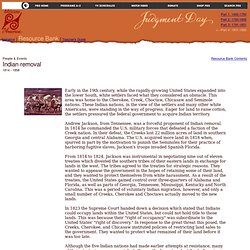
This area was home to the Cherokee, Creek, Choctaw, Chicasaw and Seminole nations. These Indian nations, in the view of the settlers and many other white Americans, were standing in the way of progress. Eager for land to raise cotton, the settlers pressured the federal government to acquire Indian territory. Andrew Jackson, from Tennessee, was a forceful proponent of Indian removal. In 1814 he commanded the U.S. military forces that defeated a faction of the Creek nation. American Experience. OF MICE AND MEN - The Student Survival Guide. American Life Histories: Manuscripts from the Federal Writers' Project, 1936 - 1940. This collection of life histories consists of approximately 2,900 documents, compiled and transcribed by more than 300 writers from 24 states, working on the Folklore Project of the Federal Writers’ Project, a New Deal jobs program that was part of the U.S.
Works Progress (later Work Projects) Administration (WPA) from 1936 to 1940. New Deal Programs: Brother, Can You Spare a Dime? - Preparation - Lesson Plans - For Teachers. Skip navigation Library of Congress Teachers Suggestions enabled. The Library of Congress > Teachers > Classroom Materials > Lesson Plans > New Deal Programs. Mice Ch 1 and 2 Questions.